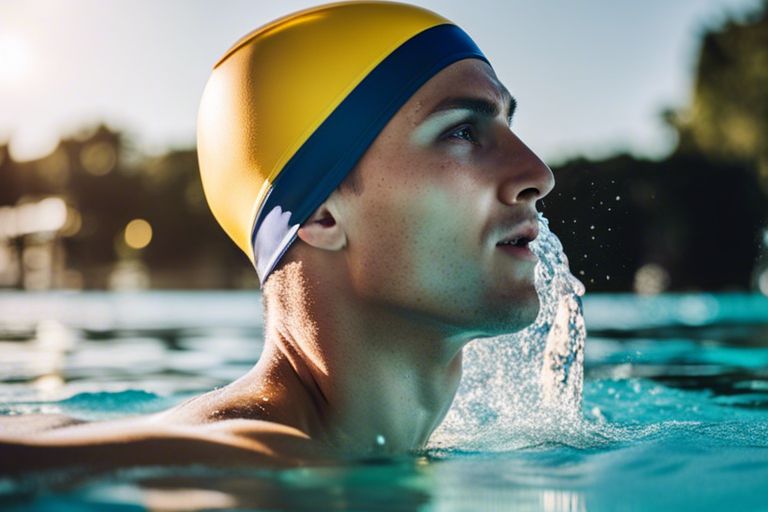Most novice and seasoned swimmers use swim caps for various reasons beyond just keeping hair dry. These snug-fitting silicone or latex caps serve multiple purposes, including reducing drag in the water, protecting hair from chlorine damage, and helping swimmers maintain a consistent body temperature. Understanding the benefits of swim caps can improve your overall swimming experience and performance in the pool.

Key Takeaways:
- Protection: Swim caps provide protection for your hair against chlorine, salt, and other chemicals in the water.
- Hygiene: They help keep your hair out of your face and prevent it from clogging pool filters.
- Performance: Swim caps reduce drag in the water, which can improve your speed and overall performance during swimming activities.
Types of Swim Caps
Your choice of swim cap can significantly impact your swimming experience. There are various types of swim caps available, each catering to different needs and preferences. Understanding the differences between them can help you select the most suitable option for your activities. This chart breaks down the common types of swim caps available:
| Latex Swim Caps | Silicone Swim Caps |
| Lycra Swim Caps | Neoprene Swim Caps |
Latex Swim Caps
Types of Swim caps made of latex are affordable and provide a snug fit. They are lightweight and offer minimal drag in the water.
Silicone Swim Caps
Types of swim caps made of silicone are durable, hypoallergenic, and more comfortable than latex caps. They are ideal for swimmers with latex allergies and long hair.
Swimmers commonly choose silicone swim caps for their sleek design and the ability to keep hair relatively dry during swimming sessions.
Lycra Swim Caps
Caps made of Lycra are soft, lightweight, and comfortable. They are popular among recreational swimmers and young swimmers as they are easy to put on and take off.
This type of swim cap is not as snug-fitting as latex or silicone caps, but they are great for keeping hair in place and providing some protection against chlorine.
Neoprene Swim Caps
On colder days or for open water swimming, neoprene swim caps are the preferred choice. These caps are thicker and provide insulation to keep the head warm in cold water.
Swim caps made of neoprene are also buoyant, aiding in keeping the swimmer afloat and visible in open water conditions.

Benefits of Using Swim Caps
Reduced Hydrodynamic Drag
Any Swim Cap Guide | Protecting Your Hair While Swimming swimmer knows that reduced hydrodynamic drag can make a significant difference in their performance. Swim caps create a smoother surface in the water, allowing swimmers to glide more easily and swiftly through the pool.
Protection for Hair from Chlorine
Chlorine can be harsh on your hair, leading to dryness, discoloration, and damage. Any swimmer who regularly exposes their hair to chlorinated water should consider using a swim cap to provide a protective barrier. Swim caps help minimize the contact your hair has with chlorinated water, reducing the negative effects on your locks.
Improved Visibility and Safety
Any swim cap provides more than just protection for your hair; they also come in bright colors that improve your visibility in the water. This added visibility can increase safety by making it easier for lifeguards and fellow swimmers to spot you in the pool.
Improved visibility and safety go hand in hand when it comes to swimming. By wearing a brightly colored swim cap, you not only enhance your visibility for others but also increase your own awareness of your surroundings while in the water, reducing the chances of accidents or collisions.
Thermal Protection in Cold Water
Chlorine can strip your hair of its natural oils, leaving it prone to becoming brittle and weak. Cold water can exacerbate this problem by further drying out your hair. A swim cap acts as a barrier, protecting your hair from the cold water and helping to maintain its natural oils and moisture.

Choosing the Right Swim Cap
Considerations Based on Swimmer Type
Based on the type of swimmer you are, whether a competitive athlete or a recreational swimmer, you may have different requirements for a swim cap. Competitive swimmers may prioritize hydrodynamics and reduced drag, while recreational swimmers may focus more on comfort and ease of use.
Fit and Comfort
For a swim cap to be effective, it must fit well and be comfortable to wear. A tight-fitting cap reduces drag and keeps hair in place, while a comfortable cap ensures that you can focus on your swim without distractions.
For instance, silicone caps are known for their durability and flexibility, making them a popular choice for frequent swimmers. Additionally, caps with ergonomic designs and seamless construction enhance comfort during long swims.
Durability and Maintenance
One key factor to consider when choosing a swim cap is its durability and maintenance requirements. Look for caps made from high-quality materials that can withstand repeated use and exposure to chlorine and other chemicals in the pool.
Swimmer, remember to rinse your cap with fresh water after each use and allow it to air dry completely to prevent mold and prolong its lifespan.
Common Questions about Swim Caps
Can Swim Caps Keep Hair Completely Dry?
Questions often arise about whether swim caps can keep hair completely dry. While swim caps are designed to reduce water exposure to the hair, they may not always keep hair completely dry. Factors such as the material of the cap and how tightly it fits can affect its ability to keep hair dry.
How to Properly Wear a Swim Cap?
Questions about how to properly wear a swim cap are common among swimmers. The key to wearing a swim cap correctly is to ensure it is snugly fitted over the head, covering the ears and hairline. Start by placing the cap over the forehead and stretching it towards the back of the head, ensuring a secure fit.
The proper technique for wearing a swim cap involves tucking in any stray hairs and ensuring a tight seal to prevent water from seeping in during swimming sessions.
Handling and Care Tips
- Always rinse your swim cap with fresh water after each use
- Avoid exposing your swim cap to direct sunlight for prolonged periods
Hair care needs to be considered when handling swim caps. Wet swim caps should be carefully dried and stored in a cool, dry place to prevent mold and bacteria growth. The longevity of a swim cap can be extended with proper care and maintenance.
- Avoid twisting or folding the cap excessively
- Store the swim cap away from sharp objects to prevent tears or damage
The key to ensuring the durability of your swim cap is to handle it with care and follow specific maintenance guidelines to keep it in optimal condition for repeated use.
To wrap up
Hence, swim caps serve various purposes including hair protection, drag reduction, and increased speed in performance. Whether it’s for recreational swimming or competitive races, wearing a swim cap can bring multiple benefits to swimmers of all levels. Understanding the reasons behind using swim caps can help individuals make informed decisions on whether to incorporate them into their swimming routine.
FAQ
Q: What are swim caps for?
A: Swim caps are designed to provide swimmers with several benefits including reducing drag in the water, keeping hair out of the face and mouth, protecting hair from chlorine damage, and making swimmers more streamlined and hydrodynamic in the water.
Q: How do swim caps reduce drag in the water?
A: Swim caps are made from materials, such as silicone or latex, that create a smooth surface that helps reduce friction as a swimmer moves through the water. This reduction in drag can lead to faster swim times and improved performance in the pool.
Q: Are swim caps necessary for all swimmers?
A: While swim caps are not mandatory for all swimmers, they are highly recommended for competitive swimmers looking to improve their performance. Recreational swimmers may also benefit from wearing swim caps to keep their hair dry and protected from chlorine while swimming.



